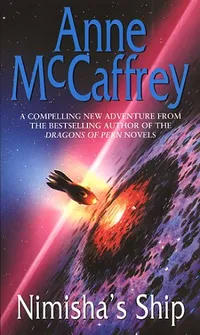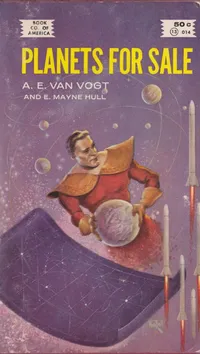Planets for Sale!
The question of who owns space, its resources and its symbolic rights is one that becomes more pressing as commercial spaceflight advances. A well known rap artist even claimed recently to have “legally” purchased an exoplanet - WASP-127b - to the frustration of the exoplanet researchers who discovered and worked on it [1]. As has been discussed in many places elsewhere there is no current legal mechanism which permits such purchases, and indeed an international treaty bans nations - and by implication other human entities - from asserting ownership over the “common heritage of mankind”.
However, ambiguities and complications remain in space law and certainly science fiction has provided a rich environment in which to explore questions of sovereignty and ownership in outer space.
Dependence or Independence?
At the very dawn of humanity’s Space Age, the Outer Space Treaty of 1966 established the principle that Earth-bound nations can not claim territory in outer space. Nonetheless, both before and after this declaration, science fiction has explored the possibility of state-sponsored colonisation of space - whether that state is a national polity, or a planetary government representing the whole Earth (which would not in itself be against the treaty).
While there are a variety of ways such narratives can play out, a common theme is the struggle of established colonies to assert their independence from the home planet or nation. Crucially this can only realistically occur after the colony has established a viable self-sustaining biosphere in some form, and is either no longer dependent on the home planet for supplies, or has sufficient trade goods to bargain for their requirements. As some observers have noted, for American authors and readers this scenario conjures echoes of the US War of Independence, as well as invoking the libertarian, small-government ethos popular in some sectors of US society.
 A well-known example of this philosophical and political position can be found in Robert A. Heinlein’s novel The Moon is a Harsh Mistress (1966). In this story, the inmates and descendants of a state-sponsored prison encampment on the Earth’s Moon seek to assert their independence from the home world, assisted by a supercomputer system that has achieved self-awareness. Given that hydroponically-grown lunar grain is a major food source for Earth, the home planet is reluctant to let the supply go, and a campaign of both propaganda and military action follows.
A well-known example of this philosophical and political position can be found in Robert A. Heinlein’s novel The Moon is a Harsh Mistress (1966). In this story, the inmates and descendants of a state-sponsored prison encampment on the Earth’s Moon seek to assert their independence from the home world, assisted by a supercomputer system that has achieved self-awareness. Given that hydroponically-grown lunar grain is a major food source for Earth, the home planet is reluctant to let the supply go, and a campaign of both propaganda and military action follows.
A similar militaristic response to attempted planetary or Solar System independence efforts appears in other US SF, such as in Fire Time (Anderson 1974) and the Expanse series (Corey 2011-date). A notable example occurs in television series Babylon 5 (1993-1998). Throughout the five year story arc, EarthGov wages an ongoing war with “insurgents” and “rebels” who are seeking independence for their colony on Mars. The eponymous space station Babylon 5 itself declares independence from the Earth Alliance as the series develops, and faces an aggressive attempt by Earth to reassert its authority.
There are challenging issues to be addressed by fiction of this kind, and these overlap in places with the dialogue in post-colonial science fiction, where similar questions of independence, identity, debt, reparations and obligation are considered. Rather than questions of science, many of these are issues of economics and politics. What return can a parent-planet reasonably expect on its investment in planting a colony? And at what point is a colony sufficiently mature and stable (both politically and economically) to reasonably expect self-governance? And who gets to make such decisions? These are questions that have been asked repeatedly here on Earth, and science fiction is no closer to resolving them.
It is worth noting though that the scientific and technical challenges needed to even reach this stage are not inconsiderable - the colonists would need a system of transporting or refining sufficient mineral resources to build technology, modifying or adapting their environment to secure potable water and breathable air, and must also establish a viable and secure food supply. All of these aspects of practical independence, in addition to dealing with the personal and social teething troubles of establishing stable government, are necessary prerequisites for successful political independence… and none of them are easy.
Finders keepers
Where state bodies or other organised groups settle a planet, there is often a clear chain of authority, albeit one that is often in need of modification. This is likely oversimplistic. An entire sub-genre of science fiction also explores commercial space exploration and corporate ownership of asteroids or planets, where rights of ownership are assigned to companies that settle, mine or terraform a world [2]. Again parallels can be drawn to examples from Earth history, such as the British East India Company or the similar international trading companies established by other nations. However corporations too have structures of governance and authority. By contrast, the actions of individuals are harder to predict or regulate, and science fiction also allows us to explore what happens when individuals (rather than organisations) claim ownership of worlds.
This is relatively rare in SF, and where it appears is usually associated with a pioneer environment in which the first settlers to “stake a claim” or the first children to be born on a planet are deemed to be the owners of that world. In many science fiction examples, this status is perhaps unofficial - individuals are seen to be the only people to occupy planets, in scenarios where habitable planets are abundant and overriding authority unclear, and so might be considered de-facto owners (several examples in Star Trek and Doctor Who might fit in this category).
However in some cases, the legal status is explicitly articulated. Perhaps unsurprisingly, given his libertarian ethos, Heinlein explored these ideas in his fiction. One of his early fix-up novels (narratives formed of connected short stories) was The Man who Sold the Moon (1950), following the efforts of an entrepreneur, D. D. Harriman. While Harriman aims to take personal possession of the Moon, pursuing that goal through a variety of financial and publicity scams, ultimately he settles for arranging a corporate ownership under his own control, derailing the aspirations of individual nation states.
A more interesting argument concerning personal ownership of space appears in Heinlein’s cult novel Stranger in a Strange Land (1961). This follows the life of a young man, Valentine Michael Smith, who was born in a failed Mars colony and became the only survivor. After being raised by sentient native life forms, he is returned to Earth by the second mission to arrive and finds that he has a legal claim to ownership of the entire planet of Mars, based on an earlier ruling which had granted ownership of the Moon to other individual settlers ("the Larkin decision"). Unsurprisingly, given that Mars is itself inhabited by a sentient race, this Earth-centric legislative ownership is rapidly challenged, but not until it has been used to guarantee that the Ancient Ones of Mars would themselves be recognised as having rights to the planet, rather than the human settlers.
 Nonetheless, this is not the only example of planet ownership being linked to right of birth. Anne McCaffrey’s novel Nimisha’s Ship (1998) describes a society in which the descendants of the first settlers are marked by tattooed necklaces at birth which denote their rights of ownership on their home planet. While this is a situation of long standing and power and sovereignty has been diluted amongst a number of First Families on Nimisha's homeworld, a crash landing on an unexplored planet, followed by the birth of infants amongst the shipwrecked survivors, entitles those infants to legal ownership of the new world, which they name Erewhon. As the eponymous Lady Nimisha notes to her partner:
Nonetheless, this is not the only example of planet ownership being linked to right of birth. Anne McCaffrey’s novel Nimisha’s Ship (1998) describes a society in which the descendants of the first settlers are marked by tattooed necklaces at birth which denote their rights of ownership on their home planet. While this is a situation of long standing and power and sovereignty has been diluted amongst a number of First Families on Nimisha's homeworld, a crash landing on an unexplored planet, followed by the birth of infants amongst the shipwrecked survivors, entitles those infants to legal ownership of the new world, which they name Erewhon. As the eponymous Lady Nimisha notes to her partner:
‘Let me remind you that WE are the first families of Erewhon and that’s an achievement reserved to two families alone! Not many planets can boast that kind of hierarchy. Or do I mean hegemony?’
‘Oligarchy?’ Jon put in.
‘Aristocracy… of some sort or another.’
- Nimisha’s Ship (McCaffrey, 1999, corgi edition, pg 311)
Regardless of their exact title, the premise that colonisation grants personal ownership to the settlers appears firmly established. Again, the presence of a native species, the Sh’im, complicates the question of overall sovereignty, but nonetheless a new pair of First Families is born and their legal claim to the planet recognised.
Private Planets
For the majority, the physical and mental stresses of settling their own new world, let alone the technical difficulty and vast expense, are probably beyond reach. However, inevitably, science fiction also provides a shortcut for the wealthy… just as billionaires on Earth might buy a private island, science fiction explores the possibility of future magnates buying their own private planet.
This trade of the future is perhaps most memorably invoked by Douglas Adams’ 1978 radio play The Hitchhiker’s Guide of the Galaxy (and subsequent book, television and film versions). Here the world and people of Magrathea made their name at the height of a galaxy-wide financial boom, when individuals were becoming excessively wealthy:
“For these extremely rich merchants life eventually became rather dull and it seemed that none of the worlds they settled on was entirely satisfactory. Either the climate wasn’t quite right in the later part of the afternoon, or the day was half an hour too long, or the sea was just the wrong shade of pink. And thus were created the conditions for a staggering new form of industry: custom-made, luxury planet building.” HHGTTG, BBC Radio, Fit the Fifth.
The ludicrous energy requirements for planet building, the impossibility of constructing a stable functional ecosystem, climate and mineral processing cycle from scratch, and the sheer cost of the endeavour need hardly be explained. The ultimate luxury status symbol, custom planet-ownership is only practical at the height of a growing galactic economy, and the Magratheans in the narrative spent cosmic recessions in suspended animation as a result. As always with Adams, the Hitchhiker’s take is comedic, but stands as a satire against excessive wealth and indulgence on a more terrestrial scale.

The extended Doctor Who universe also provides a prominent example of a privately-owned planetoid. The Braxiatel Collection (which appears in Doctor Who novels and audio adventures and is a major feature of the Bernice Summerfield spin-off series by Big Finish productions, is introduced in the novel Theatre of War, Richards 1994). It is described as a planetoid won in a card game by Irving Braxiatel, specifically to provide a home for his extensive museum collection and its associated research community. Again, it is a little unclear which authority actually recognised ownership of the planetoid (aka KS159) and, indeed, several of the adventures featuring this world revolve around negotiations and fights to maintain its independence from neighbouring galactic powers.
Perhaps inevitably, given the scales involved, these are relatively rare examples, with most private planets in science fiction dominated economically by an individual rather than explicitly purchased outright. Even a novel titled Planets for Sale! (E M Hull and A E van Vogt, 1954 [3]) recounts a frontier opportunity for a Harriman-like entrepreneur, Artur Blord, to act as a big “operator”, accumulating riches and de-facto control of worlds, rather than overt selling of planets. Nonetheless the front cover of the 1965 "Book Company of America" edition (shown to the right) strongly suggests ownership, with a broad-shouldered man (his silhouette boosted by impressive epaulettes) grasping a planet in his bare hands while reviewing a map of local space. While book covers are notoriously unreliable indicators of their contents, this seems a fairly good representation of the narrative in this case.
Fundamentally, there are two questions to be asked here:
-
- Who has the right to assign ownership of a planet? Those in possession, as is the case for settlers? Those in financial control, such as corporations and entrepreneurs? Those in authority, for example an intergalactic empire which controls the volume of space in which the planet is sited? Or those on Earth staking claims to planets that may never be reached?
- Is it possible (or necessary) for an individual to take personal possession of anything as large as a world? In the Magrathean case where planets are constructed on demand, "and no one was really poor (at least no one worth speaking of)", there’s an argument that private ownership is reasonable. However unlike the limited area of a private tropical island, the chances of a single individual (or even family) utilising or visiting more than a fraction of a private world is tiny. On the other hand, the prospect of an individual (or corporate entity) claiming the rights to the minerals and other resources, regardless of who actually occupies the world, would seem worryingly plausible (presuming, of course, straightforward interplanetary travel).
At present neither of these questions has been answered, although both come up for discussion in the active field of space law, as well as in science fiction. Given what we now know about the solar system, and our current (non-existent) capacity for interstellar flight, there are unlikely to be resolutions to these questions any time soon. While corporate prospects for space mining are occasionally discussed, these are not currently financial viable and are certainly out of the reach of any individual, even the well-known, space-focussed billionaires.
So can a rapper claim ownership of a planet? Can you gift a loved one a patch of the Moon or Mars for their birthday? By all means. But don’t expect those claims to have any legal standing - even if the nominal ‘owners’ are able to make good their claims by actually reaching their stakeholds, we are a long way from having a legal structure in place to validate them.
"Planets for Sale", Elizabeth Stanway, Cosmic Stories blog, 31st October 2021.
Notes:
[1] The discovery of WASP-127b was, in fact, led by Kristine Lam, a PhD student, and colleagues here at Warwick, based on data from the excellent SuperWASP telescope. A number of academic publications have followed since. [Back to text]
[2] One example amongst many here might be the world of Pandora, claimed by a vast semi-governmental but still for-profit corporation known as the "Resources Development Administration", in the world of James Cameron's 2009 movie Avatar. [Back to text]
[3] Planets for Sale! is a fixup novel comprised of short stories originally published by Edna Mayne Hull. Later editions added the name of her husband, well-known author A E van Vogt, who may have acted as an editor or even co-writer. Eventually, Hull’s name was removed from reprints and the book was published as by van Vogt, but shows clear stylistic differences from most of his work. Notably, the book features more female characters than most of van Vogt’s writing, giving them careers and important narrative roles, albeit still subject to idolisation of, and sexual advances from, their employer. [Back to text]
